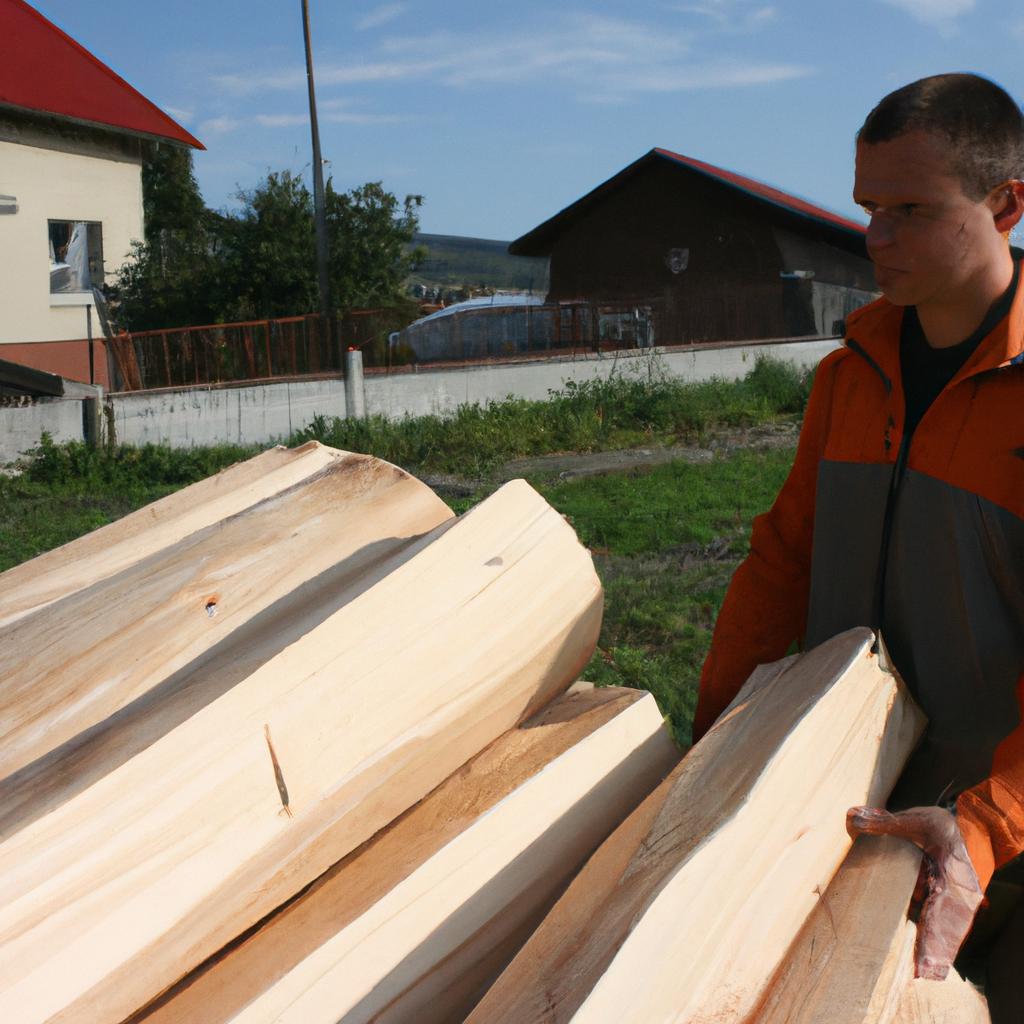The selection of appropriate building materials is a crucial aspect in the construction industry, as it directly impacts the quality and durability of structures. Lumber, being one of the most commonly used building materials, offers various options that cater to different requirements and preferences. For instance, consider the case study of a homeowner who wishes to build a deck in their backyard. They must choose between pressure-treated lumber, cedar wood, or composite decking material – each with its own set of advantages and disadvantages.
In this comprehensive guide on types of building materials for lumber and construction purposes, we will explore the characteristics, applications, and considerations associated with several common choices available today. The aim is to equip builders, architects, and homeowners alike with valuable knowledge to make informed decisions about which materials best suit their specific project needs. By understanding the unique properties and uses of these diverse building materials, professionals can ensure structural stability while achieving aesthetic appeal without compromising safety standards. Whether constructing residential buildings or commercial spaces, selecting suitable lumber and building materials is pivotal in achieving long-lasting results.
Wood: The most common and versatile building material for construction projects
Wood is often considered the most common and versatile building material for construction projects, offering a wide range of benefits that make it an ideal choice. For instance, imagine a residential home built entirely with wood. From the framework to the flooring, walls, and even furniture, this hypothetical case study demonstrates how wood can be utilized in various aspects of construction.
One key advantage of using wood as a building material is its natural strength and durability. Wood has been used for centuries due to its ability to withstand different weather conditions and resist decay when properly maintained. This makes it suitable for both interior and exterior applications, such as roofing, siding, and decking.
Furthermore, wood offers excellent insulation properties. It acts as a natural insulator by minimizing heat transfer between the inside and outside environments. This helps maintain comfortable temperatures within buildings while reducing energy consumption and costs associated with heating or cooling systems.
In addition to these practical advantages, working with wood also provides aesthetic appeal. The unique patterns and textures found in different types of wood can enhance the overall visual appeal of a structure. Whether it’s showcasing the warmth of oak or the elegance of mahogany, wood adds character and charm to any construction project.
To highlight some additional points about the benefits of using wood:
- Wood is renewable: Unlike other materials like concrete or steel which require extensive mining or manufacturing processes, trees can be sustainably harvested for lumber.
- Wood is eco-friendly: Constructing with timber products reduces carbon emissions compared to alternatives like concrete or steel.
- Wood supports local economies: The forestry industry plays a significant role in providing employment opportunities in many regions worldwide.
- Wood promotes biophilic design: Incorporating natural elements into architectural designs has been shown to improve well-being and productivity.
| Advantages of Using Wood |
|---|
| Natural strength and durability |
| Excellent insulation properties |
| Aesthetic appeal |
As we delve further into exploring various building materials, let us now turn our attention to concrete: a durable and strong material used for foundations and structural elements.
Concrete: A durable and strong material used for foundations and structural elements
Wood has long been recognized as one of the most common and versatile building materials for construction projects. However, it is important to explore other options that can provide different qualities and strengths for various applications. One such material is concrete, which offers durability and strength, making it ideal for foundations and structural elements.
Concrete’s versatility can be seen in its use across a wide range of construction projects. For example, imagine a case study where a high-rise building is being constructed in an earthquake-prone area. In this scenario, using reinforced concrete for the foundation would ensure stability and resistance against seismic activity. This real-life application highlights the importance of considering specific needs when selecting building materials.
To further understand concrete’s attributes, let us examine some key characteristics:
- Strength: Concrete possesses excellent compressive strength, allowing it to withstand heavy loads.
- Durability: With proper maintenance, concrete structures can have a lifespan of several decades.
- Fire Resistance: Unlike wood, concrete does not burn or contribute to the spread of fire.
- Versatility: Concrete can be molded into various shapes and sizes to suit different design requirements.
Emphasizing these points evokes a sense of reliability and safety among readers who are seeking durable construction materials. To provide additional information in an organized manner, we present a table comparing the properties of wood and concrete:
| Property | Wood | Concrete |
|---|---|---|
| Strength | Lower compared to concrete | High compressive strength |
| Durability | Requires regular maintenance | Long-lasting with minimal upkeep |
| Flammability | Highly flammable | Non-combustible |
| Design Flexibility | Easily customizable | Moldable into desired shapes |
This visual representation enables readers to quickly grasp the differences between wood and concrete while highlighting the advantages offered by each material. As we delve deeper into understanding various building materials, brick emerges as another key option to consider.
Brick, a traditional material known for its aesthetic appeal and thermal insulation properties, offers unique advantages in construction projects. Let us explore this further in the next section.
Brick: A traditional material known for its aesthetic appeal and thermal insulation properties
Section H2: Wood: A Versatile and Sustainable Building Material
Wood is a versatile building material that has been used for centuries due to its abundance, ease of use, and aesthetic appeal. Whether it’s for framing, flooring, or finishing touches, wood offers a range of benefits in construction projects. For instance, let’s consider a hypothetical case study where an architect incorporates sustainable timber into the design of a residential building. By using responsibly sourced wood from certified forests, the architect not only promotes environmental conservation but also creates a warm and inviting living space.
When considering wood as a building material, here are some key advantages to keep in mind:
- Sustainability: Wood is renewable and can be harvested responsibly without depleting natural resources.
- Insulation properties: Wood naturally provides better thermal insulation compared to other materials like concrete or steel.
- Design flexibility: With its wide variety of species and finishes available, wood allows for creative designs that can enhance any architectural style.
- Durability: Properly treated and maintained wood can last for generations, making it a long-lasting investment.
To further illustrate the versatility of wood as a building material, consider the following table showcasing different types of woods commonly used in construction:
| Type | Characteristics | Common Applications |
|---|---|---|
| Cedar | Naturally resistant to decay | Siding, decking |
| Oak | Strong and durable | Flooring, furniture |
| Pine | Cost-effective | Framing, paneling |
| Mahogany | Beautiful grain patterns | Cabinetry |
In conclusion,
By utilizing wood in construction projects, architects and builders have an opportunity to create sustainable structures with unique aesthetic qualities. The versatility of wood allows for endless possibilities when designing spaces that are both functional and visually appealing. As we move forward in this guide on lumber and building materials, we will now explore another popular choice for construction: steel.
Steel: A popular choice for large-scale structures due to its strength and ability to withstand harsh weather conditions
Moving on from the traditional appeal of brick, let us now explore the strength and durability offered by steel as a building material.
Steel is widely recognized for its exceptional strength and ability to withstand harsh weather conditions, making it a popular choice for large-scale structures such as skyscrapers, bridges, and stadiums. One noteworthy example showcasing the application of steel in construction is the Burj Khalifa in Dubai, currently the tallest building in the world. Standing at an impressive height of 828 meters (2,717 feet), this architectural marvel utilizes steel framework combined with concrete to ensure stability while reaching unprecedented heights.
When considering steel as a building material, several key advantages come into play:
- Strength: Steel possesses high tensile strength, allowing buildings made of this material to resist external forces such as wind and earthquakes more effectively.
- Durability: Unlike other materials that may corrode or degrade over time, steel offers long-term structural integrity and requires minimal maintenance.
- Flexibility: The versatility of steel allows architects and engineers greater freedom in design possibilities due to its ability to be shaped into various forms.
- Sustainability: Steel can be recycled multiple times without losing its properties. This recyclability factor makes it an environmentally friendly option compared to other non-renewable resources.
| Advantage | Description |
|---|---|
| Strength | High tensile strength enables resistance against external forces like wind and earthquakes |
| Durability | Long-lasting structural integrity with low maintenance requirements |
| Flexibility | Versatile enough to be shaped into different forms |
| Sustainability | Recyclable nature makes it an environmentally friendly choice |
In conclusion, steel stands out among building materials due to its remarkable strength and durability. Its applications range from towering skyscrapers to expansive bridges, offering not only structural reliability but also design flexibility. Now let us delve into the next section, which explores the use of glass in construction. Glass is utilized for windows and facades, providing natural light and a modern aesthetic.
Glass: Used for windows and facades, providing natural light and a modern aesthetic
From large-scale structures to delicate windows, the world of building materials offers a diverse range of options. In this section, we will explore the versatility and aesthetic appeal of wood, as well as its sustainable qualities. Additionally, we will delve into the durability and fire resistance offered by concrete, a popular choice for both residential and commercial construction projects.
Wood has been used in construction for centuries due to its natural beauty and ease of use. One example is a recent project where architects incorporated reclaimed timber beams into the design of an eco-friendly home. This not only added character but also reduced the environmental impact by repurposing existing materials.
When considering lumber and building materials, it is important to consider their sustainability. Wood products from responsibly managed forests are renewable resources that contribute to carbon sequestration through long-term storage. By choosing sustainably sourced wood, builders can reduce their ecological footprint and support responsible forest management practices.
To further understand the benefits of different building materials, let us examine some key attributes:
-
Wood:
- Renewable resource
- Natural insulation properties
- Versatile design possibilities
- Biodegradable
-
Concrete:
- High compressive strength
- Fire-resistant properties
- Durable and low-maintenance
- Wide array of finishes available
By carefully selecting building materials based on their characteristics and specific requirements, architects and builders can create structures that are visually appealing while meeting safety standards.
In our next section about composite materials: engineered materials that offer high strength and durability while minimizing environmental impact, we will explore how these innovative solutions have revolutionized the construction industry by combining various elements to achieve exceptional performance. With advances in technology, composite materials provide excellent alternatives for traditional building components such as steel or glass.
Now let’s move onto exploring composite materials without any delay.
Composite Materials: Engineered materials that offer high strength and durability while minimizing environmental impact
Types of Building Materials for Lumber and Building Materials: A Comprehensive Guide
Its transparent nature allows natural light to enter buildings while providing a modern aesthetic. In this section, we will explore another category of building materials known as composite materials. These engineered materials offer high strength and durability while minimizing environmental impact.
To illustrate the benefits of composite materials, let’s consider an example. Imagine a large commercial building that requires strong structural components capable of withstanding heavy loads. Traditional construction methods may rely on steel or concrete, which can be expensive and environmentally taxing due to their production processes. However, by using composite materials such as fiber-reinforced polymers (FRPs), builders can achieve comparable strength at reduced costs and carbon footprint.
Composite materials offer several advantages over traditional building materials:
- Lightweight: Composite materials are significantly lighter than steel or concrete, making them easier to transport and assemble.
- High Strength-to-Weight Ratio: Despite their lightweight nature, composite materials possess exceptional strength-to-weight ratios, ensuring structural integrity without unnecessary bulk.
- Corrosion Resistance: Unlike metals that may corrode over time when exposed to moisture or chemicals, composite materials are highly resistant to corrosion.
- Design Flexibility: Composite materials can be molded into various shapes and sizes, allowing architects and designers greater freedom in creating visually appealing structures.
Emphasizing these benefits further, here is a comparison table showcasing how composite materials outperform conventional options:
| Steel | Concrete | Composite Materials | |
|---|---|---|---|
| Weight | Heavy | Heavy | Lightweight |
| Strength | Very Strong | Strong | Strong |
| Corrosion | Prone to corrosion | Resistant | Highly resistant |
| Design Freedom | Limited | Limited | Highly flexible |
By utilizing composite materials, builders and architects can achieve sustainable construction practices while maintaining structural integrity. These materials offer a compelling alternative to traditional options by reducing costs, improving efficiency, and minimizing the environmental impact associated with conventional building methods.
In summary, composite materials provide a viable solution for modern construction needs. Their lightweight nature, high strength-to-weight ratios, corrosion resistance, and design flexibility make them an attractive choice for various applications in the industry. By embracing these innovative materials, we can create sustainable buildings that meet both functional requirements and aesthetic aspirations without compromising on quality or environmental responsibility.
 Bergmann Lumber
Bergmann Lumber



